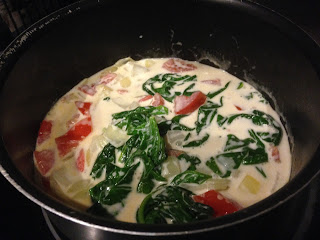When it comes to food from the Pacific islands, it seems as though all roads lead back to palu sami. As I've made palu sami twice before (once when I was blogging about Kiribati in 2009 and again when I was blogging about Fiji in 2012), I was determined to cook something else this time!
Unfortunately, my internet searches for the Solomon Islands' national dish came to a dead end - one website even suggested the Middle Eastern Kibbeh as the national dish of the Solomon Islands, but that just didn't seem right to me!
So I improvised! Interestingly, whilst reading my blog post about cooking palu sami as part of my research on Fiji - I'd noted how far along my cooking had come since 2009 - that I was now able to improvise and didn't feel the need to stick to the exact recipe. Well, I guess this current recipe is a step further for me, as I'm not only improvising, but adapting one nation's dish and giving it a make-over with another nation's staple foods.
I chose Fish and chips for several reasons - mainly because all my reading suggested that, despite their love of tinned meats like corned beef and spam, people do still eat a lot of fish in the Pacific islands. I also found out that people in Melanesia love sweet potato, so that gave me the idea of making sweet potato chips or wedges.
Perhaps most importantly, I wanted to pay homage to the fact that the Solomon Islands were once a British territory, so my Pacific-style fish and chips is an attempt to capture the history, as well as the cuisine of this island nation.
The Sweet Potato mystery
 |
| My photo of sweet potato |
When I was researching for my blog posts on Oaxaca, Mexico - I first came across the concept of the Columbian Exchange - how European contact with Central America saw the introduction of tomatoes, potatoes, chillies, chocolate and many other crops to the diets of people outside the Americas.
Unfortunately, the other half of the exchange meant death, disease and decimation of the native American populations!
The interesting thing about the sweet potato is that it appeared in the Pacific islands before the Columbian exchange. No-one quite knows how the sweet potato ended up in places like Samoa, the Solomon Islands, Philippines and Japan, but somehow it happened and sweet potato has been a part of the Pacific diet for more than 1,000 years!
The Ingredients
4 fish fillets
3 limes
1 bunch of spinach
4 sweet potatoes (cut into chips)
1 tomato
1 onion
1/2 tin of coconut milk
How I made the sweet potato chips
The first thing I did was to prepare the sweet potato - peeling off the reddish-coloured skin and chopping the flesh into chips or wedges.
 |
| Peel the sweet potatoes and cut them into wedges |
I then parboiled the chips, before roasting them in the oven. I did think about deep-fat frying the chips but, in my (admittedly limited!) experience of Pacific-island cuisine, they seem to bake things more than fry them, so I thought baked sweet potato wedges would be the best option.
 |
| Parboil the sweet potato chips . . |
 |
| . . then bake them in the oven |
How I prepared the fish and sauce mixture
I used fish fillets that had been frozen - defrosted them and marinated them for a couple of hours in lime juice, sprinkled with some rind.
 |
| Marinate the fish fillets in lime juice |
I decided to also bake the fish, so put the fillets into an oven dish, in the marinade liquid, covered it with tinfoil and baked it for about twenty-five minutes, at the same time as the sweet potato was baking.
 |
| Bake the fish for about twenty-five minutes |
To prepare the ingredients for the sauce, I washed the spinach and chopped the tomato and onion.
 |
| Wash the spinach |
 |
| Chop the tomato and onion |
I fried the tomato and onion on a fairly high temperature, so they would make a kind of paste.
 |
| Fry the tomato and onion in a saucepan |
I then added the spinach and coconut milk, bringing the mixture to the boil, before simmering for around twenty minutes.
 |
| Add the spinach and coconut milk |
The end result was really rather tasty!
 |
| Pacific-style Fish and Chips |
Image credits:
All photos were taken by me on my trusty iPhone - please feel free to re-use them under the Creative Commons license: Attribution, Share Alike, Non-commercial












